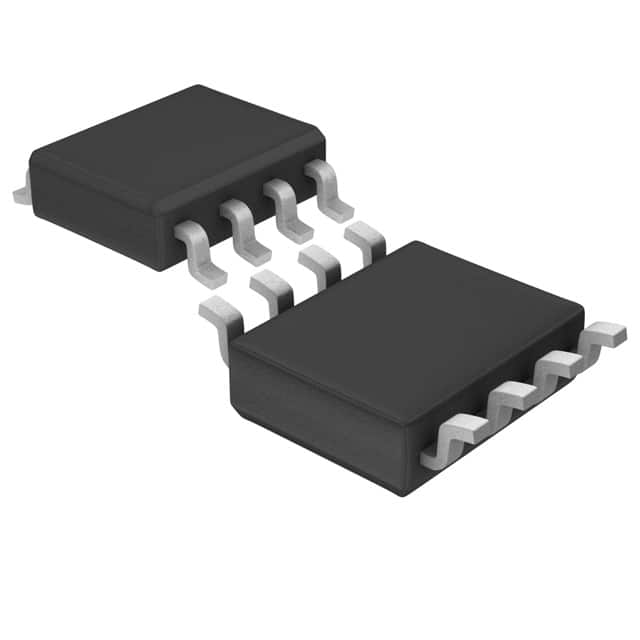LT1461BCS8-3.3#PBF
Overview
Product Category
The LT1461BCS8-3.3#PBF belongs to the category of voltage references.
Use
This product is primarily used as a precision voltage reference in various electronic circuits.
Characteristics
- High accuracy and stability
- Low temperature coefficient
- Low output noise
- Wide operating temperature range
- Small package size
Package
The LT1461BCS8-3.3#PBF is available in an 8-pin surface mount package (SOIC-8).
Essence
The essence of LT1461BCS8-3.3#PBF lies in its ability to provide a stable and accurate voltage reference for precise circuit operation.
Packaging/Quantity
This product is typically packaged in reels or tubes, with a quantity of 2500 units per reel/tube.
Specifications
- Output Voltage: 3.3V
- Initial Accuracy: ±0.05%
- Temperature Coefficient: 10ppm/°C
- Output Noise: 4μVrms (10Hz to 100kHz)
- Operating Temperature Range: -40°C to 125°C
- Supply Voltage Range: 2.7V to 20V
- Quiescent Current: 80μA
Pin Configuration
The LT1461BCS8-3.3#PBF has the following pin configuration:
```
| | --| VOUT | --| GND | --| TRIM | --| NC | --| NC | --| VIN | --| SHDN | |___________| ```
Functional Features
- High precision voltage reference
- Low power consumption
- Shutdown mode for power saving
- Trim pin for fine adjustment
- Short circuit and thermal protection
Advantages
- Excellent accuracy and stability
- Low temperature coefficient ensures reliable performance over a wide temperature range
- Low output noise for clean signal processing
- Small package size allows for space-saving designs
- Shutdown mode helps conserve power in battery-operated applications
Disadvantages
- Relatively higher cost compared to standard voltage references
- Limited output voltage options (only 3.3V in this case)
Working Principles
The LT1461BCS8-3.3#PBF is based on a bandgap reference circuit that generates a stable voltage reference using the temperature-dependent characteristics of semiconductor materials. This reference voltage is then amplified and regulated to provide a precise and stable output voltage.
Application Field Plans
The LT1461BCS8-3.3#PBF finds extensive use in various applications, including:
- Precision analog-to-digital converters (ADCs)
- Digital-to-analog converters (DACs)
- Voltage regulators
- Oscillators and frequency synthesizers
- Sensor calibration circuits
- Battery management systems
- Test and measurement equipment
- Industrial control systems
Alternative Models
Some alternative models that can be considered as alternatives to LT1461BCS8-3.3#PBF include:
- LM4040 from Texas Instruments
- MAX619 from Maxim Integrated
- REF3030 from Analog Devices
- ADR3412 from Analog Devices
- LT6654 from Linear Technology
These models offer similar functionality and performance characteristics, providing designers with flexibility in choosing the most suitable voltage reference for their specific application requirements.
In conclusion, the LT1461BCS8-3.3#PBF is a high-precision voltage reference with excellent stability, low noise, and a wide operating temperature range. Its small package size and various features make it suitable for a wide range of applications in the electronics industry.
قم بإدراج 10 أسئلة وإجابات شائعة تتعلق بتطبيق LT1461BCS8-3.3#PBF في الحلول التقنية
Sure! Here are 10 common questions and answers related to the application of LT1461BCS8-3.3#PBF in technical solutions:
Q1: What is the LT1461BCS8-3.3#PBF? A1: The LT1461BCS8-3.3#PBF is a precision voltage reference IC manufactured by Linear Technology (now part of Analog Devices). It provides a stable and accurate output voltage of 3.3V.
Q2: What is the typical application of LT1461BCS8-3.3#PBF? A2: The LT1461BCS8-3.3#PBF is commonly used as a voltage reference in various electronic circuits, such as analog-to-digital converters (ADCs), digital-to-analog converters (DACs), power supplies, and sensor interfaces.
Q3: What is the voltage accuracy of LT1461BCS8-3.3#PBF? A3: The LT1461BCS8-3.3#PBF has a typical voltage accuracy of ±0.05% at room temperature. This means that the actual output voltage will be within 0.05% of the specified 3.3V.
Q4: What is the temperature coefficient of LT1461BCS8-3.3#PBF? A4: The temperature coefficient of the LT1461BCS8-3.3#PBF is typically 10ppm/°C. This means that for every degree Celsius change in temperature, the output voltage will change by approximately 10 parts per million (ppm).
Q5: What is the maximum current that LT1461BCS8-3.3#PBF can source or sink? A5: The LT1461BCS8-3.3#PBF can source or sink a maximum current of 10mA. It is important to ensure that the load connected to the voltage reference does not exceed this limit.
Q6: What is the operating temperature range of LT1461BCS8-3.3#PBF? A6: The LT1461BCS8-3.3#PBF is designed to operate within a temperature range of -40°C to +125°C. It is suitable for use in both industrial and automotive applications.
Q7: Does LT1461BCS8-3.3#PBF require an external capacitor for stability? A7: Yes, the LT1461BCS8-3.3#PBF requires an external bypass capacitor for stability. A 0.1μF ceramic capacitor is recommended to be placed close to the IC's VOUT and GND pins.
Q8: Can LT1461BCS8-3.3#PBF operate from a single power supply? A8: Yes, the LT1461BCS8-3.3#PBF can operate from a single power supply. It requires a minimum supply voltage of 4.5V and can handle a maximum supply voltage of 20V.
Q9: Is LT1461BCS8-3.3#PBF available in other output voltage options? A9: Yes, the LT1461BCS8 series is available in various output voltage options. Apart from 3.3V, it is also available in 2.5V, 2.048V, and other common voltage levels.
Q10: Can LT1461BCS8-3.3#PBF be used in battery-powered applications? A10: Yes, the LT1461BCS8-3.3#PBF can be used in battery-powered applications. Its low quiescent current of typically 60μA makes it suitable for power-constrained designs.
Please note that the answers provided here are general and may vary depending on specific application requirements. It is always recommended to refer to the datasheet and consult with the manufacturer for detailed information.


